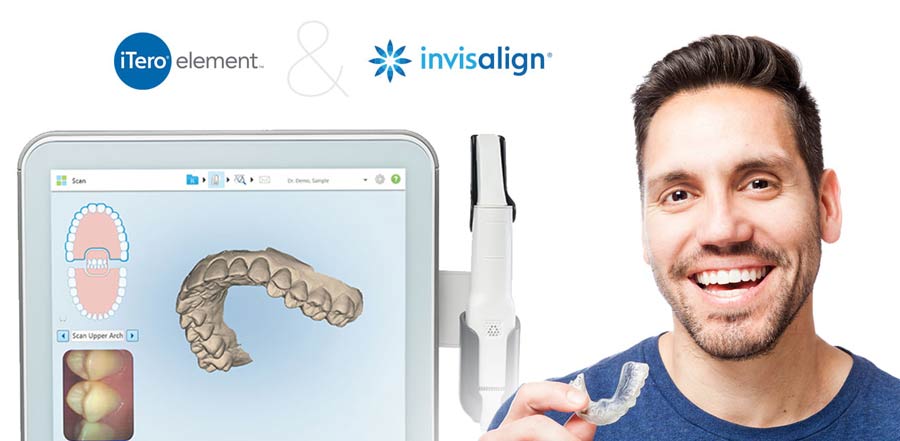My name is Alex Crespi, and I am the proud co-founder of Miami Lakes Orthodontics. I have the privilege of working with my beautiful wife, who just so happens to be an award-winning orthodontic specialist, Dr. Carmen Briceño Crespi. Together we have helped over 11,000 people to raise their self-esteem and achieve a beautiful smile through our orthodontic treatments such as braces and Invisalign. One of the most exciting parts of my career is sitting with patients, listening to their stories, and helping them find a solution to fix their smiles.
One of the most frequent questions I get from our adult patients is helping them decide which type of treatment they should choose. I often hear, “OK, Alex, I want to fix my teeth, but how do I know if I should choose braces or Invisalign?” This isn’t always a simple choice, as there are several things to consider when choosing your treatment type.
How to choose between braces or Invisalign?
First of all, are you a candidate for Invisalign? Often, patients will come into our office and want Invisalign treatment to fix their teeth. However, before prescribing Invisalign, we always have to ensure that the patient is best treated with Invisalign. We have to ensure that we can accomplish our treatment goals with Invisalign before offering the treatment. To ensure that Invisalign treatment is possible, we take a quick exam and X-ray in the office. This lets us be 100% certain that we are offering you the best solution to fix your smile and accomplish your goals.
If you are a candidate for Invisalign, the next question should be whether you prefer to use braces or Invisalign. The reason to choose one treatment over the other should be based on what you feel will work best for your lifestyle and budget, as well as the level of involvement/responsibility that you want to take on with your treatment. I have listed some of the pros and cons of braces and Invisalign to help you decide.
Why choose Invisalign over braces:
- Appearance – Invisalign is clear and virtually unnoticeable to other people. Your appearance will stay almost identical, as you will not have braces on your teeth.
- Eating – You will eat the same way you do not with Invisalign as you take off the aligners to eat your food. Braces can make eating a bit more tedious.
- Hygiene – Cleaning your teeth with Invisalign is the same as cleaning your teeth right now. You take off the aligners to brush, floss, and rinse your teeth.
- Comfort – No wires or braces in your mouth makes Invisalign more comfortable as nothing is rubbing against your lips or cheeks.
- No risk of injury playing sports – Invisalign is safer for athletes as there is no risk of having metal braces that can potentially cut the lips or cheeks if there is an impact.
- No emergency appointments for broken braces – Many patients and parents like that Invisalign does not have emergency appointments for broken braces or appliances.
Why choose braces over Invisalign:
- Less daily responsibility – Patients wearing braces do not have to worry about taking them off and putting them back on as they have to do with Invisalign. Once the braces are placed on the teeth, they do their job and move your teeth toward the final position. Invisalign only works when it is on your teeth, and not wearing them for enough time (22 hours per day) can delay treatment results.
- No opportunity for losing aligners and delaying results – Losing or misplacing your Invisalign aligners can slow down your treatment results and cause delays in your overall treatment time.
- Not having to take Invisalign on and off frequently for eating and drinking – Many patients say that although they have to be a bit more cautious when eating and drinking with braces, they still prefer braces over Invisalign because they can eat and drink most things without having to take off their mounts. With Invisalign, you must take off the aligners when eating or drinking (except water), which can become frustrating.
- Parents like to have control over their kid’s treatment – Many parents prefer braces over Invisalign as it takes away the opportunity for their kids to be non-compliant. “How will I know if my son or daughter is wearing the aligners?”
- Braces are more effective for complex issues – Although Invisalign has made significant advancements in tooth movement technology, braces can accomplish more complex movements than Invisalign.
I hope this information clears up some of the differences between braces and Invisalign. It is important to remember that regardless of which type of treatment you prefer you should always start your process by getting the opinion of an orthodontic specialist. Board-certified board-certified years of specialized training and experience can help you understand your options and get a proper diagnosis-certified orthodontist near you using the orthodontic locator tool on the ABO website.
If you are in or near Miami Lakes, Florida, visit us (click here) or call 305-820-6800 and schedule your free initial exam and X-ray today. Contact Miami Lakes Orthodontics, and always remember to smile with confidence!


